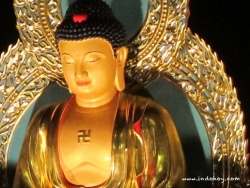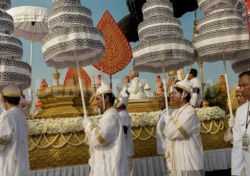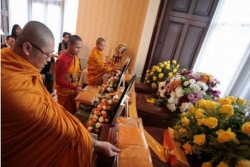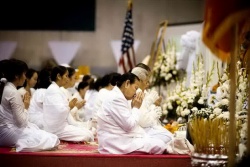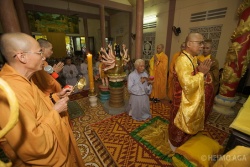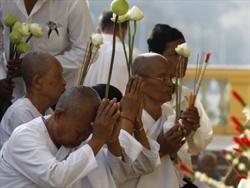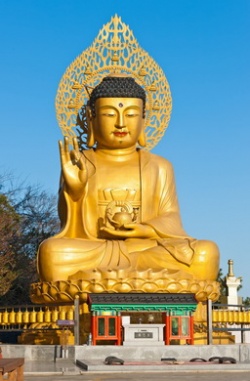Inquiry Report on Zen Buddhist Funeral Ritual
by Theresa Hanley
Ch'an was introduced to China from in the first century A.D. Ch'an was the Chinese response to Indian thought. The Chinese were not so philosophically minded as the Indians. They are practical people devoted to worldly affairs. "They are attached to the earth: they are not star gazers."(1)
William Bodiford in Zen in the Art of Funerals, states that Ch'an Buddhism originated and remained in monasteries in China.. It was informed through Sung philosophy, explained as "the science of the Tao". The Sung philosophers all studied Zen and put much significance on the experience of sudden illumination after meditation on the study of the classics. The ideal of man's life was to cultivate the virtue of sincerity. Not only Japanese travellers returning from China but Chinese monks settling in Japan brought Sung philosophy along with Zen. Eventually, Japanese monks travelled to China to study Ch'an. When they returned, they also brought back books of Confucianism and Taoism In Japan since the introduction of Sung philosophy there has been a consistent attempt to syncretize the three teachings of Confucianism Buddhism and Shintoism.
When Ch'an Buddhism came to Japan, in the sixth century, funerals began to be performed with Buddhist rites for lay people. It was known as Zen Buddhism in Japan, and in time, the Zen monks, following the Chinese tradition of sharing their enlightenment, started to perform Zen funeral rites for lay people
There was only one hitch. A person had to be a Buddhist monk to receive a Buddhist funeral. To fulfill these conditions, Japanese Zen monks began ordaining lay men and women.
How this practice originated and eventually developed to include the Japanese innovation of posthumous ordinations for laymen is the focus of this paper.
. There was a rethinking of Chinese Zen monks in the ninth century. "It is clear from many sources that, in addition to their practice of silent meditation, Chinese monks of this period pursued a theoretical practice aimed at rethinking the entire domain of meditation. The founder of this, Ma-tsu claimed that "everyday mind is the way"(2).
Huang Po followed this theory, and developed excellent texts reflecting this Zen from the early Sung period. Zen was now informing all aspects of living. "Rather than limiting meditation to a certain number of hours in the meditation hall, monks were encouraged to live all moments of life meditatively". Zen meditation was found in samatha, stopping thought activity and purifying the mind, and also vipassana, philosophical meditation. Samatha clears the mind of pointless and frenetic activity, opening the senses to experience the world in a way that was formerly obscured to the practitioner. Vipassana is the process of the mind being enlightened through a transformation in thinking.
Alan Cole, in Upside down, right Side Up: a revisionist History of Buddhist Funerals in China details the practices of medieval Ch'an (Zen) Buddhist monasteries There is some information that about this time Zen monks were editing and printing the textbooks of Confucianism and Buddhism. They were invited by the provincial lords to look after the education of their vassals.
In Chinese medieval monasteries, certain masters were enlightened and this Buddha wisdom was transmitted in the manner of father to son, through a lineage of enlightened beings that went back to Bodhidharma, who supposedly had brought it from India.
"From the outset, Chan ideology was conservative: it sought to locate enlightenment... by imagining that the spiritual essence of Buddhism was transmitted to them in Confucian moulds of family practice and was ready to be passed on to the next generation as though it were a family heirloom."(3) This was passed on at the death of the abbott to his chosen "sons". The funeral of the abbott represented this transference of the essence of Buddha enlightenment. Because of this, the funeral of the abbott differed greatly from the funeral of an ordinary monk. The elaborate funeral rituals for the abbott signified the transference of power, while in the case of the ordinary monk, the rituals consisted on moving the body and spirit of the dead monk out of the monastic community.
In Japanese Buddhism there is a clear connection to the traditions of China. Buddhist funeral rites were developed by Chinese Buddhists, and all the monastic codes that Japanese Zen monks follow are based on Chinese monastic codes that tie into Confucian thought. The first detailed account of Chinese Buddhist funeral rites is found in an eleventh- century Chinese Buddhist encyclopaedia. It contains twenty-six entries on funeral rites, most of which are explained by means of quotations from the Confucian classics.
Zen monks first popularized the widespread practice of Buddhist funerals in Japan. Historically, only the wealthy nobility added Buddhist services to the traditional Japanese funeral rites. The majority of Japanese, lacking wealth, did not have access to the Buddhist clergy. It was Zen monks that introduced affordable funeral rites. When the Zen Master Dogen founded his monasteries in the countryside, he provided the same Zen rituals as were performed for the wealthy. In China, Zen funerals were only performed for ordained monks living in the monastery, not for laymen. There is early historical records of two funerals in Japan that point to the fact there was no distinction between the funerals for an abbot within the monastery and a layman from outside the monastery(4)
Early Soto Zen Masters implied that ordination with the precepts (essence of Buddha nature) is equivalent to the attainment of Buddhahood itself. Therefore, ordination was all important.
"For a Zen funeral to be performed, first the deceased must be ordained as a Zen monk. The popularization of Zen funerals and the popularization of lay ordinations, therefore, entailed one another."(5) Zen funerals began to be popular with the ordinary Japanese people, where they too could be ordained as a monk before death.. This parallels the medieval Christian practice of monastic vows taken in grave danger of dying so that an individual could have access to a monastic funeral. However, individual religious conviction in Soto Zen ordinations was not so important.
Public ordination ceremonies were group affairs, at which whole households, servants and collateral families accompanied a village leader or a family elder. The essential passivity of the lay participants is nowhere evident than in the fact that Zen ordinations could be, and most often were, conducted posthumously.
One of the more amazing concepts of lay ordinations at this time was that the dead are ideal Zen monks because they have left behind the boundaries of worldly distinction. That the corpse could not answer the questions put to it was interpreted by the medieval Soto monks as "the ultimate affirmative response to proper Zen expression of the effable"(6).
"The art of Soto Zen funerals that gave Japanese laymen and women the understanding of enlightenment can be understood as "laying at the heart of the development of the lay-centred Zen tradition found in modern Japan"(7)
How Buddhism became lay-centred has to do with a shift in Japan in the early nineteenth from a feudal society. At this time, every Buddhist sect was a state religion, and the temples served the function of the smallest units of feudal control.. The Buddhist priests, their position assured by official status, were in the position of the ruling class. They administered education to the people in accordance to the dictates of the feudal authorities.(8)
By the end of the nineteenth century, the feudal order had crumbled. The separation and independence of various denominations in Buddhism was generally recognized.
`Hommon Butsuryuko. Developed in Kyoto in 1857, is the forerunner of lay organizations focussing their belief around Lotus Sutra. This is one of the most important Mahayana Buddhist texts, used in nearly every Buddhist school of thought in Japan. This poetic text describes how Mahayana Buddhism with its promise of enlightenment and salvation for everyone came into being (9) Hommon Butsuryuko brought in lay believers as a religious association founded by the Buddha for the spread of the truth of Buddhism. Temples and priests were rejected and a faith in the Lotus sutra was preached concentrated on one theme, that of ths-worldly benefit(10)
In modern times. Among the various sects of the Nichiren line which criticised the existing politics and society and favoured a social ethic, in late Tougawa there arose criticism of the rigidity of Buddhist sects and their powerlessness under the Bakuhan system. As a result, movements of lay believers became active. 45
Today, in Japan, once monks return to their villages, the performing lay-oriented services, especially funeral services in the local temple occupy most of their time.
Buddhist funerals are not external to traditional Zen practice. The image of Zen as a religion of artistic insight and enlightenment is incomplete. In Japan, Zen monks always have used their powers of insight and enlightenment to serve the more immediate worldly needs of their patrons. The realm of Zen enlightenment extended beyond the monastery walls into the homes of the laymen(11)
Today, Zen Buddhist monks through their practice of rituals and the sharing of their knowledge, keep alive a religious tradition in Japan. " Many Soto funeral sermons assert that the dead neither ascend (tendo) nor fall into hell (jigoku), a statement that could be construed to agree with the traditional Japanese belief that ancestors remain in a nebulous proximity to their descendants."(12)
Zen Buddhist monks are not embracing a life of penance or expiating sin.
On the contrary they are working on a Zen Buddhist theological education which in a surprisingly short time gives them a conspicuous physical and psychical well-being which most clearly is expressed in a strong independence of manner and a spontaneously affectionate and creative personality.(13)
To illustrate this, I am including a description of G. Victor Sogen Hori's account of life in a Rinzai monastery.
What is interesting here is this is the Buddhist monk who gave a lecture at STU last fall on Japanese rituals for children that had died before or after birth. (I remember he said the term for a child that died before birth was a "water child".) He is an assistant professor in religious Studies at McGill and is currently working on a translation of a Rinzai monastery handbook, Zenrin Kushu.
Since Buddhist monks play such a prominent role in the formal religious life of Japan, I thought this article would be interesting, plus maybe answer a few questions about living a life dedicated to the principles of Zen.
How does a person begin to understand Zen? Or narrowing it a bit, how do we understand the life of a person who dedicates his life to Zen , such as Buddhist monk?
Hori explains that when a person begins the life of a Buddhist monk (Shinto, new arrival) he must immediately learn the monastery routine.
Ancient tradition rests heavily upon the new monks. The Roshi (Zen Master-"aged teacher") and older monks remind the new arrivals that the robes, rituals, sutras, language, personal relations, and the entire life of Zen training itself dates back to the ancient past and that the new monks must do their share in preserving this ancient tradition against the encroachments of modern life, Much of a monk's life consists of committing sutras and Zen texts to rote memory, practising traditional forms of ceremony and ritual, and in general, eating, dressing, speaking and living in a style reminiscent of medieval Japan.
This illustrates the main way of learning in a Buddhist monastery. The monk must maintain the formal ritual life of the monastery but is not told how to do it. Contrary to seeing these activities as people imitating "the unthinking repetition of tradition", the Zen monastery requires that all this is done without teaching them how it all is to be done. This encourages "on the spot adaptability". With each monk developing his own solution to continue the traditions.
This monastery method is "Teaching without Teaching" An example of this is what the new cook goes through. He is humiliated in front of the others every time he makes a mistake and more;
If the monks eat up all the food he has served, he must scurry around and cook more food while the monks wait impatiently at table. If he makes too much food, he is forced to eat all the leftovers. After the meal is over, one of the head monks may further criticize him for not using the heaps of cabbage sitting ripe in the fields, or for overcooking the squash, or for always making the same few dishes...the new cook suffers this constant harassment until he can cook properly, manage the kitchen without making mistakes, and use all the temple's food supplies resourcefully. He is greatly motivated to learn all this as soon as possible.
The thinking here, is that a student learns when he is strongly motivated to learn, receiving criticism from his teacher when he tries the hardest.
The entire discipline of monastery teaching and learning is constructed upon this assumption, that true teaching and learning cannot occur while the student remains a passive recipient of the teacher's instructions, but occurs only when the student is actively motivated to learn.
Which brings me to the question of what is the reason of being hit with a stick? Hori says that this is "Zen kindness" as in Buddhism freedom is the notion of being free from one's wants and desires. The constant need to protect and enhance ourselves makes us unfree. Hori recalls being hit with the stick more than 500 hundred times in four days. Later on he lost count, but estimated he received well over a thousand hits by the end of a week.
What was really surprising was Hori's account of "informal side" of being a monk.
Monks look forward to begging days since they have a chance to remove themselves from the watchful eye of the head monk. Sometimes they enjoy themselves so much that they come back slightly drunk. Late at night, after meditation, some of the monks may gather for a cigarette where the firewood is stacked. Pulling a piece of wood from the stack, one will reach in and pull out a bottle of whiskey. Suddenly everyone has a teacup in hand and little pieces of dried fish are passed around. In monastery language this is sarei, "tea ceremony."
Other monks may climb over the wall to go to the local public bath and afterward enjoy a bowl of noodles. Some of the more adventurous ones may even head downtown to sing in the karioke bars, always mindful that wake-up is 3:30 or 4 A.M. Of course, in the monastery there will be one or two monks who are very fussy about keeping all the rules, and they will receive their share of good-natured kidding, perhaps even be dragged against their will on some outrageous escapade.
Hori explains that "few people can live he entirely and completely in the abrasive world of strict discipline". In fact, he argues, "one might even argue that monks can practice with such discipline only because they play so hard on the shadow side."
Hori explains that this aspect of monastery life has two purposes:
1."In addition to allowing the monks time and space for rest and relaxation, the behind-the -scenes life of play teaches monks not to make a religion out of Zen practice, not to treat the monastery as something holy.
2.While the formal life of monastery discipline often isolates a monk and tests his individual personal resources, the shadow life affirms that beyond distinctions of rank and office, all monks share common social bonds and a fundamental humanity."
Both the formal and the informal life of the monastery are thought to be equally important in Zen practice."
This puts a very different spin on the practice of Zen as understood in Western culture! Of this, Hori points out that "Individualism, anti-authoritarianism the self of feeling , rejection of institutions are the things that western interpreters of Zen have wanted to find in Zen. One should not be surprise at how American (how Protestant) the chorus of claims made about Zen sound. Zen is not a religion, Zen is individualism, Zen is iconoclastic, Zen is anti-ritualistic. But in this American interpretation of Zen, ritual formalism and mystical insight are diametrically opposed.
Ritual formalism is thought to be the very thing that prevents free expression. Hori states that one who only has these concepts will not understand: "ritual formalism is the means to mystical insight."(14)
Endnotes
1. Daisetz T. Suzuki Zen in Japanese Culture (1959)
2. Dale Wright, in "Zen in Theory and Practice" in Philosophical Meditations on Zen Buddhism. New York. Cambridge University Press 1998
3. Alan Cole Upside down, right Side Up: a Revisionist History of Buddhist Funerals in China The University of Chicago (1996)
4. The funerals of Hojo Tokimne and Yoshito are described in Zen in the Art o f Funerals : ritual Salvation in Japanese Buddhism, William Bodiford History of Religions, University of Chicago, (2000)
5. Ibid
6. Ibid
7. William Bodiford
8. Shigeyoshi Murakami Japanese Religion in the Modern Century (1968) University of Tokyo Press pg. 5-6, pg. 96
9. Ian Reader Japanese Religions Past and Present (1993) Kent. Japan Library pg. 36
10. Shigeyoshi Murakami pg. 17
11. William Bodiford
12. Japanese conceptions of where the departed reside are discussed in Robert J. Smith, Ancestor Worship in Contemporary Japan (Stanford Calif,: Stanford University Press. 1974) pp. 63-68
13. Ian Reader Japanese Religions Past and Present (1993) pg. 114
14. G. Victor Sogen Hori "Teaching and Learning in the Rinzai Zen Monastery"The Journal of Japanese Studies Vol. 29 1994: Winter pp. 5-35
Bibliography
Bodiford William "Zen in the Art of Funerals :Ritual Salvation in Japanese Buddhism", Historyof Religions, University of Chicago, (2000)
Cole Alan Upside down, right Side Up: a Revisionist History of Buddhist Funerals in China The University of Chicago (1996)
Hori, G. Victor Sogen "Teaching and Learning in the Rinzai Zen Monastery" The Journal of Japanese Studies Vol. 29 1994: Winter
Murakami Shigeyoshi Japanese Religion in the Modern Century. University of Tokyo Press (1968)
Reader Ian. Japanese Religions Past and Present .Kent. Japan Library (1993)
Smith, Robert J. Ancestor Worship in Contemporary Japan. Stanford California Stanford University Press. 1974
Suzuki, Daisetz T. Zen in Japanese Culture . New York Princeton University Press (1959)
Wright, Dale. "Zen in Theory and Practice" in Philosophical Meditations on Zen Buddhism. New York. Cambridge University Press 1998
